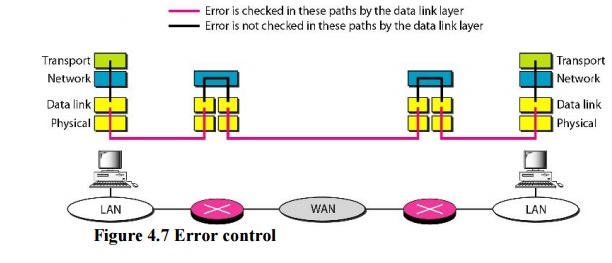Chapter: Computer Networks : Transport Layer
Process to Process Delivery in Transport Layer
Process to Process Delivery:
The data
link layer is responsible for delivery of frames between two neighboring nodes
over a link. This is called node-to-node delivery. The network layer is
responsible for delivery of datagrams between two hosts. This is called
host-to-host delivery. Real communication takes place between two processes
(application programs). We need process-to-process delivery. The transport
layer is responsible for process-to-process delivery-the delivery of a packet,
part of a message, from one process to another. Figure 4.1 shows these three
types of deliveries and their domains

1. Client/Server Paradigm
Although
there are several ways to achieve process-to-process communication, the most
common one is through the client/server paradigm. A process on the local host,
called a client, needs services from a process usually on the remote host,
called a server. Both processes (client and server) have the same name. For
example, to get the day and time from a remote machine, we need a Daytime
client process running on the local host and a Daytime server process running
on a remote machine. For communication, we must define the following:
1.
Local host
2.
Local process
3.
Remote host
4.
Remote process
2. Addressing
Whenever
we need to deliver something to one specific destination among many, we need an
address. At the data link layer, we need a MAC address to choose one node among
several nodes if the connection is not point-to-point. A frame in the data link
layer needs a Destination MAC address for delivery and a source address for the
next node's reply.
Figure
4.2 shows this concept.

The IP
addresses and port numbers play different roles in selecting the final
destination of data. The destination IP address defines the host among the
different hosts in the world. After the host has been selected, the port number
defines one of the processes on this particular host (see Figure 4.3).

3. lANA Ranges
The lANA
(Internet Assigned Number Authority) has divided the port numbers into three
ranges: well known, registered, and dynamic (or private), as shown in Figure
4.4.
·
Well-known
ports. The ports ranging from 0 to 1023 are assigned and controlledby lANA.
These are the well-known ports.
·
Registered
ports. The ports ranging from 1024 to 49,151 are not assigned orcontrolled by
lANA. They can only be registered with lANA to prevent duplication.
·
Dynamic
ports. The ports ranging from 49,152 to 65,535 are neither controllednor
registered. They can be used by any process. These are the ephemeral ports.

4. Socket Addresses
Process-to-process
delivery needs two identifiers, IP address and the port number, at each end to
make a connection. The combination of an IP address and a port number is called
a socket address. The client socket address defines the client process uniquely
just as the server socket address defines the server process uniquely (see
Figure 4.5).
UDP or
TCP header contains the port numbers.

5. Multiplexing and
Demultiplexing
The
addressing mechanism allows multiplexing and demultiplexing by the transport
layer, as shown in Figure 4.6.
Multiplexing
At the
sender site, there may be several processes that need to send packets. However,
there is only one transport layer protocol at any time. This is a many-to-one
relationship and requires multiplexing.
Demultiplexing
At the
receiver site, the relationship is one-to-many and requires demultiplexing. The
transport layer receives datagrams from the network layer. After error checking
and dropping of the header, the transport layer delivers each message to the
appropriate process based on the port number.

6. Connectionless Versus
Connection-Oriented Service
A
transport layer protocol can either be connectionless or connection-oriented.
Connectionless
Service
In a
connectionless service, the packets are sent from one party to another with no
need for connection establishment or connection release. The packets are not
numbered; they may be delayed or lost or may arrive out of sequence. There is
no acknowledgment either.
Connection~Oriented
Service
In a
connection-oriented service, a connection is first established between the
sender and the receiver. Data are transferred. At the end, the connection is
released.
7. Reliable Versus Unreliable
The
transport layer service can be reliable or unreliable. If the application layer
program needs reliability, we use a reliable transport layer protocol by
implementing flow and error control at the transport layer. This means a slower
and more complex service.
In the
Internet, there are three common different transport layer protocols. UDP is
connectionless and unreliable; TCP and SCTP are connection oriented and
reliable. These three can respond to the demands of the application layer
programs.
The
network layer in the Internet is unreliable (best-effort delivery), we need to
implement reliability at the transport layer. To understand that error control
at the data link layer does not guarantee error control at the transport layer,
let us look at Figure 4.7.

8. Three Protocols
The
original TCP/IP protocol suite specifies two protocols for the transport layer:
UDP and TCP. We first focus on UDP, the simpler of the two, before discussing
TCP. A new transport layer protocol, SCTP, has been designed. Figure 4.8 shows
the position of these protocols in the TCP/IP protocol suite.

Related Topics